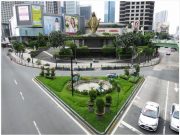Investing in real estate can be a viable strategy for wealth accumulation, and choosing the right location plays an essential role in ensuring a profitable return on investment.
The Philippines, with its vibrant economy and thriving real estate sector, offers a plethora of opportunities for both local and foreign investors. In this article, we will compare Metro Manila, the country’s bustling capital, with provincial cities to help you make an informed decision about where to invest.
I. Introduction
A. Brief Overview of the Real Estate Market in the Philippines
The real estate market in the Philippines has experienced significant growth over the past decade. This growth is attributed to several factors including strong economic performance, rapid urbanization, and a growing middle class. Furthermore, the demand for residential and commercial properties has surged, making the Philippines a lucrative destination for real estate investment.
The real estate industry in the Philippines is diverse, encompassing various sectors such as residential, commercial, and industrial. Among these, the residential sector, particularly condominiums, has been the primary driver of growth. This surge in demand is driven by young professionals, overseas Filipino workers (OFWs), and investors seeking rental income.
On the other hand, the commercial real estate sector, which includes office spaces and retail outlets, has also seen significant growth due to the expansion of the Business Process Outsourcing (BPO) industry and the influx of international retailers.
Despite the challenges posed by the COVID-19 pandemic, the Philippine real estate market has shown resilience. According to Colliers International, the property market is expected to recover by 2023 due to the country’s strong economic fundamentals and government infrastructure projects.
B. Importance of Location in Real Estate Investment
Location plays a crucial role in real estate investment. It not only determines the value of a property but also influences its potential returns. For instance, properties in prime locations often command higher prices and rental rates.
In the context of the Philippines, location becomes even more critical due to the country’s geographical diversity and varying levels of development across different regions. Major cities like Metro Manila, Cebu, and Davao are often favored for real estate investment due to their developed infrastructure, economic activity, and high population density.
However, provincial cities also present promising opportunities, especially with ongoing infrastructure projects and regional development initiatives. These areas offer a variety of properties, from affordable housing options to luxury estates, catering to diverse investor preferences.
In the next sections, we will delve deeper into the comparative analysis of Metro Manila and provincial cities in terms of real estate investment potential. Stay tuned!
II. Understanding Metro Manila’s Real Estate Market
Metro Manila, often referred to as the National Capital Region (NCR), is the economic powerhouse of the Philippines. It’s a melting pot of culture, commerce, and significant historical landmarks. It’s also the country’s most populous region, making it a prime location for real estate investment.
A. Overview of Metro Manila’s Real Estate Market
The real estate market in Metro Manila is diverse and dynamic. It comprises 16 cities and one municipality, each offering unique investment opportunities.
Key districts for investment include Makati City, Bonifacio Global City (BGC), Ortigas Center, and Quezon City. These areas are home to major business districts, shopping centers, educational institutions, and residential properties. They attract a considerable number of workers, shoppers, students, and residents daily, creating a high demand for real estate.
Property prices in these areas have been on an upward trend over the past decade, driven by strong demand and limited supply. However, due to the pandemic, there has been a slight dip in property prices, but experts predict a rebound as the economy gradually recovers.
B. Advantages of Investing in Metro Manila
Investing in Metro Manila comes with several advantages:
High Population Density
With over 12 million residents, Metro Manila offers a large pool of potential tenants and buyers, which can lead to higher rental income and property appreciation.
Robust Economic Activity
Home to several business districts, Metro Manila attracts local and foreign businesses, contributing to job creation and economic growth.
Infrastructure Development
The government’s “Build, Build, Build” initiative has led to significant infrastructure developments in Metro Manila, including new roads, bridges, and transport systems, enhancing the region’s connectivity and accessibility.
C. Challenges of Investing in Metro Manila
Despite its advantages, investing in Metro Manila also poses some challenges:
High Property Prices
Properties in Metro Manila, especially in prime locations, can be quite expensive, making it less accessible for some investors.
Traffic Congestion
Metro Manila is notorious for its heavy traffic, which can affect the quality of life and deter some potential tenants or buyers.
Overcrowding Issues
The high population density can lead to overcrowding, noise, and pollution, which could be a concern for some investors and residents.
The next section is about the real estate market in provincial cities and how they compare with Metro Manila. Stay tuned!
III. Exploring Provincial Cities’ Real Estate Market
Provincial cities in the Philippines present a unique blend of opportunities for real estate investors. While they may not have the same level of economic activity as Metro Manila, they offer lower property prices, less competition, and potential for growth due to rapid urbanization.
A. Overview of the Real Estate Market in Key Provincial Cities
Cebu
Known as the “Queen City of the South,” Cebu has a thriving real estate market. In the first half of 2022, residential condo purchases in Cebu rose significantly. Stakeholders predict a property boom in 2024 as developers race to build new projects. The median list price for houses in Cebu has risen notably. Condo prices in Cebu are expected to grow in the coming years.
Davao
Davao City, “the crown jewel of Mindanao”, has been attracting investors due to its robust economy, political stability, and infrastructural development. It offers a mix of residential, commercial, and agricultural properties.
Baguio
Baguio, the “Summer Capital of the Philippines,” is popular for its cool climate and stunning landscapes. It’s becoming an increasingly popular choice for vacation homes and transient rentals.
Iloilo
Iloilo City, known as the “City of Love,” is one of the emerging real estate markets in the Visayas region. It’s experiencing rapid urbanization, and its real estate market is buoyed by the local government’s aggressive infrastructure development and tourism promotion.
| Key Provincial Cities | Type of Real Estate Market | Advantages | Challenges |
| Cebu | Thriving with rising residential condo purchases and property prices. | Lower property prices, less competition, and rapid urbanization. | Slower economic growth, limited infrastructure, lower rental yields. |
| Davao | Growing due to a robust economy, political stability, and infrastructural development. | Lower property prices, less competition, and rapid urbanization. | Slower economic growth, limited infrastructure, lower rental yields. |
| Baguio | Popular for vacation homes and transient rentals due to its cool climate and landscapes. | Lower property prices, less competition, and rapid urbanization. | Slower economic growth, limited infrastructure, lower rental yields. |
| Iloilo | Emerging markets experiencing rapid urbanization, infrastructure development, and tourism promotion. | Lower property prices, less competition, and rapid urbanization. | Slower economic growth, limited infrastructure, lower rental yields. |
IV. Comparative Analysis: Metro Manila vs. Provincial Cities
A. Property Price Comparison
| Location | Average Property Price |
| Metro Manila | High – Metro Manila has some of the highest property prices in the country due to the concentration of businesses, commercial establishments, and premium residential areas. |
| Provincial Cities | Lower – Provincial cities generally have lower property prices due to less competition and lower cost of living. |
B. Rental Yield Comparison
| Location | Average Rental Yield |
| Metro Manila | High – The high demand for rental properties in Metro Manila due to the influx of workers and students leads to higher rental yields. |
| Provincial Cities | Moderate to Low – While there is a growing demand for rentals in provincial cities, the rental yield is typically lower compared to Metro Manila due to lower rental rates. |
C. Potential for Capital Appreciation
| Location | Potential for Capital Appreciation |
| Metro Manila | Moderate to High – Given the continuous development and urbanization, properties in Metro Manila have a good potential for capital appreciation. |
| Provincial Cities | High – Provincial cities, especially those experiencing rapid urbanization and infrastructural development, have a high potential for capital appreciation. |
D. Risk Factors
| Location | Risk Factors |
| Metro Manila | High – Risks include over-saturation of the market, potential for natural disasters, and high cost of living. |
| Provincial Cities | Moderate – Risks include slower economic growth, limited infrastructure, and dependence on local industries. |
This comparative analysis provides a general overview and can vary based on specific circumstances and timing. Investors must conduct thorough research or consult with a real estate professional, the HousingInteractive before making any investment decisions.
V. Tips for Choosing Between Metro Manila and Provincial Cities for Real Estate Investment
A. Assessing Your Investment Goals
Before investing in real estate, it’s important to clearly define your investment goals. Are you looking for high rental yields, capital appreciation, or a mix of both? Your investment goals will greatly influence the location where you should invest.
B. Understanding the Local Real Estate Market
Understanding the local real estate market is crucial when deciding between Metro Manila and provincial cities. Research about property prices, rental rates, vacancy rates, and market trends. You can do this by reading real estate reports, attending webinars, and speaking with local real estate professionals.
C. Considering the Impact of Future Developments
Future developments can significantly impact property values. For instance, the construction of new infrastructure like roads, bridges, and transportation hubs can increase property prices in the surrounding areas. Therefore, it’s essential to keep an eye on any planned developments in your chosen location.
D. Analyzing the Risk and Return
Investing in real estate involves risk, but it also offers potential returns. When choosing between Metro Manila and provincial cities, consider the risks and returns associated with each location. Metro Manila may offer higher rental yields but also comes with higher property prices and competition. On the other hand, provincial cities may offer lower property prices and less competition, but the rental yields may be lower.
VI. Conclusion
A. Recap of Key Points
The decision to invest in real estate in either Metro Manila or provincial cities in the Philippines largely depends on several factors. These factors include your investment goals, understanding of the local real estate market, consideration of future developments, and a thorough analysis of the risks and returns.
Metro Manila, being the country’s capital, often has higher property prices and rental yields due to its dense population and commercial activity. On the other hand, provincial cities may offer lower property prices with a high potential for capital appreciation, especially those under rapid urbanization and infrastructural development.
B. Final Thoughts on Where to Invest in Real Estate in the Philippines
Both Metro Manila and provincial cities have their unique advantages for real estate investment. Metro Manila is ideal for investors seeking high rental yields and a more stable market, while provincial cities are perfect for those looking for lower property prices with high potential for capital appreciation.
It’s important to note that there is no one-size-fits-all answer to this, as every investor has different priorities and risk tolerance. Therefore, it is crucial to do comprehensive research and possibly seek advice from real estate professionals before making an investment decision.

























